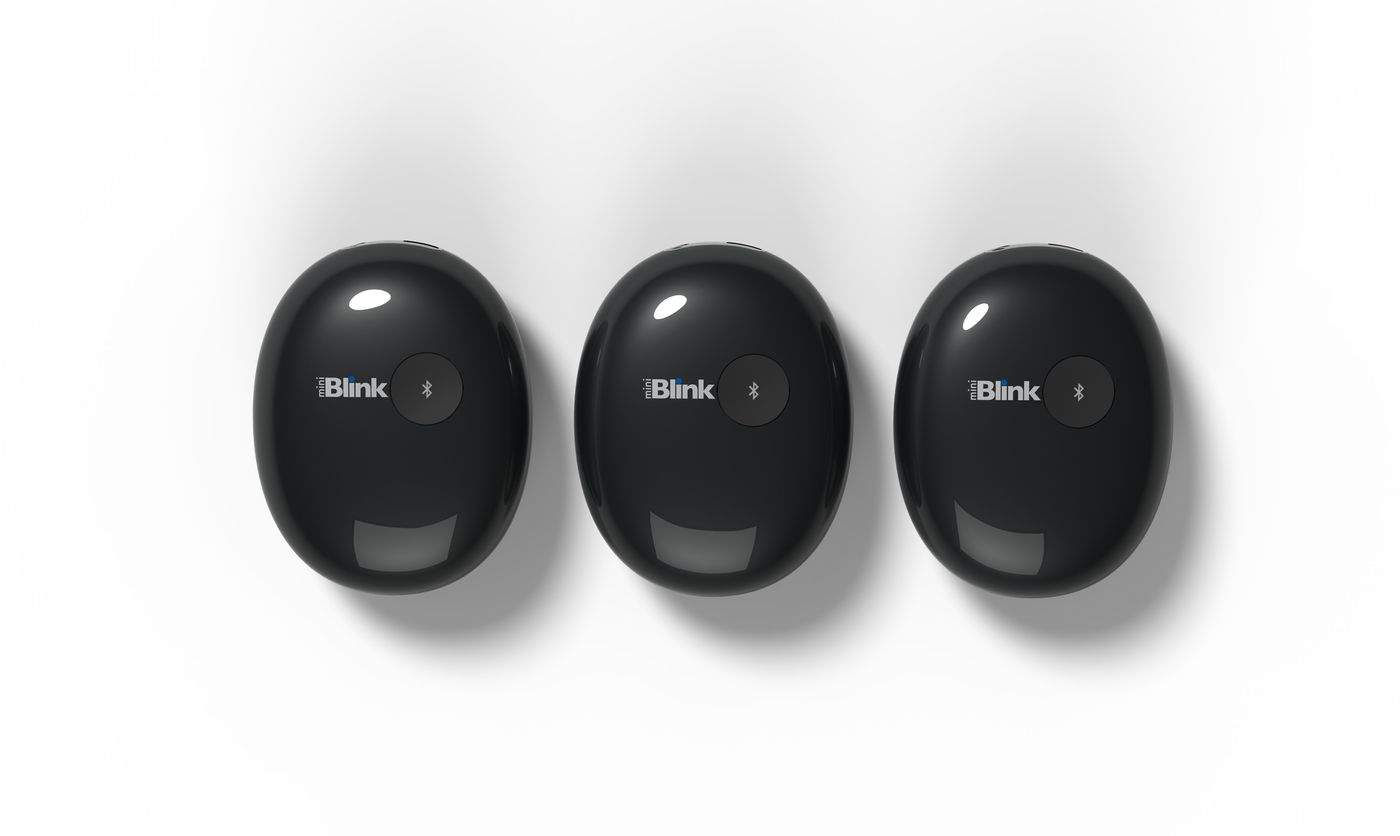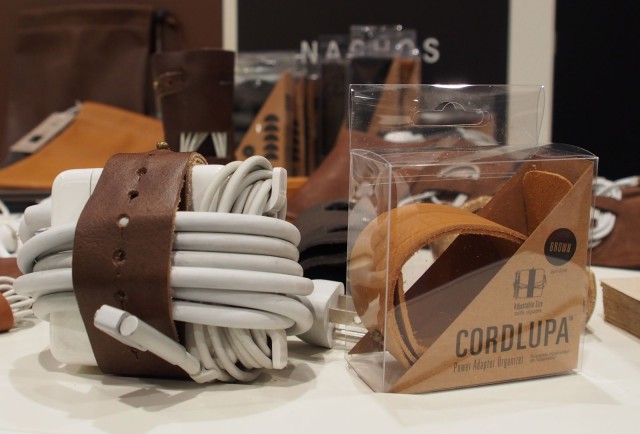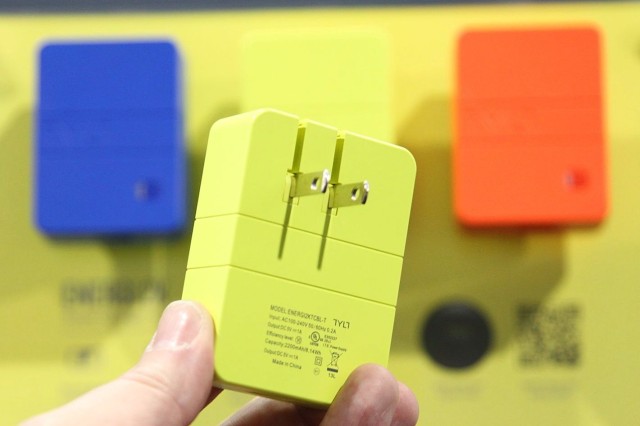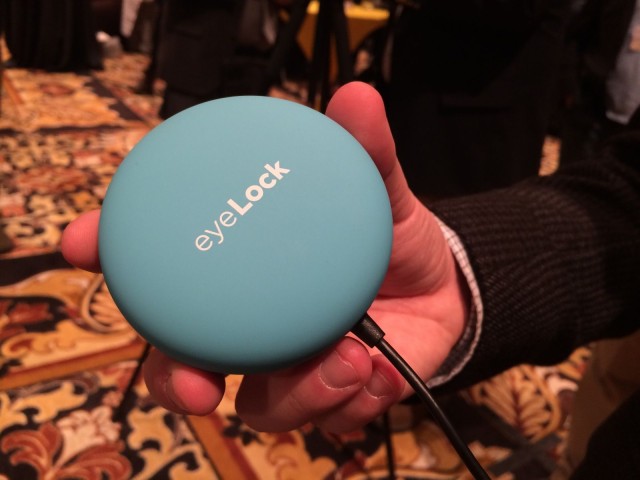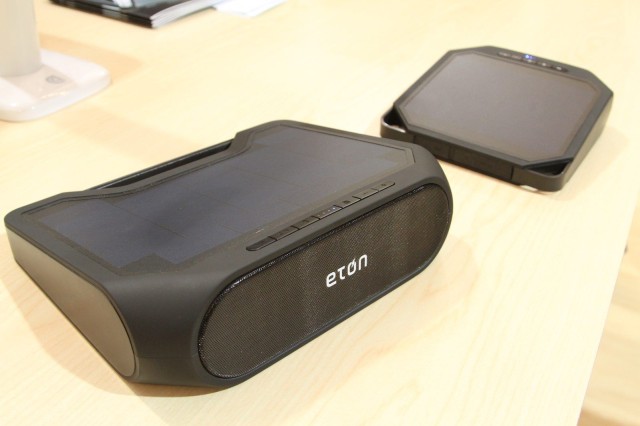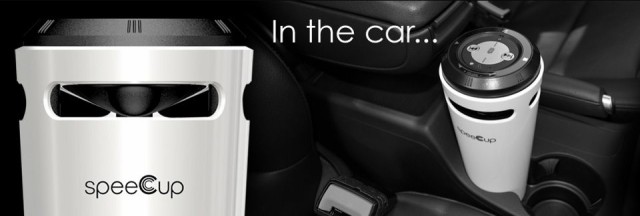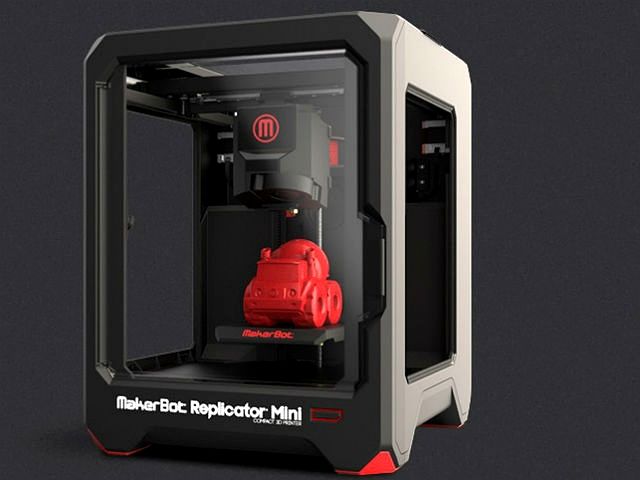The Vegas show floor was packed with options to make your work day a little more fun — whether it’s how you get there with a great computer bag or keeping your iDevice cords out of the way. Or, at the very least, sound better, judging from the number of speakers blaring through the crowd.
Here are Cult of Mac’s picks!
Arcam’s Palm-Sized Hi-Def Bluetooth Audio Receiver
Arcam, the UK high-end audio company, has a little nugget to tempt audiophiles. It’s called the miniBlink, and it’s a “hi-def” Bluetooth audio adapter with a proper built-in DAC. What? Don’t fret. It just means you can beam Bluetooth audio to your stereo without it sounding crappy.
 The miniBlink, a tiny version of the bigger rBlink, lets you stream music using the regular AAC codec, or the better-quality apt-X (already used on some of the better Bluetooth speakers out there). The little dongle also has its own high-fidelity DAC (Digital Audio Converter) that makes for an even better sound.
The miniBlink, a tiny version of the bigger rBlink, lets you stream music using the regular AAC codec, or the better-quality apt-X (already used on some of the better Bluetooth speakers out there). The little dongle also has its own high-fidelity DAC (Digital Audio Converter) that makes for an even better sound.
Sure, you should probably use a wire or lossless AirPlay for the best sound around, but Bluetooth is so convenient, reliable and instant. And at $150, the new miniBlink isn’t going to break the bank.
Source: Arcam blog
— Charlie Sorrel
Cordlupa Solves Your Cable-Tangling Problems In A Cinch
Plenty of companies have come up with cable-tidying solutions for MacBooks but few let you tame the beast as easily as this miniaturized belt for your power adapter, the Cordlupa.
 Even some of the tightest-wound power adapters will come undone after bouncing around in your bag for a few hours, so Cordlupa is designed to stay on your power adapter at all times to provide a fast and simple solution to tidy up your cables when you’re ready to travel or store the charger.
Even some of the tightest-wound power adapters will come undone after bouncing around in your bag for a few hours, so Cordlupa is designed to stay on your power adapter at all times to provide a fast and simple solution to tidy up your cables when you’re ready to travel or store the charger.
The leather loop keeps your cords from knotting and getting dirty in your bag. $25 gets you one loop in your color choice of black, brown, gray or whisky. If you want to go bonkers with your cable organization, you can splurge on This Is Ground’s new Cord Suite for 130 bucks, which also includes those delicious little cable tacos Charlie loves. — Buster Heine
This Charger Battery Is The Kind Of Smart Tech We’ll Actually Use
There’s a lot of seemingly brilliant, sexy tech here at CES. Like razor-precise, slightly annoying miniature flying drones! A case for your iPhone that gives it weird, infra-red Superman eyes!
Wonderful. But would we really end up using this stuff? I mean, yeah, we probably would. But not every day. Probably not every month. On the other hand, TYLT’s Energi 2K — a wall charger with a USB port that also houses a battery — is the kind of brilliant idea that we imagine we’d actually want to use every day.

Simple, and smart: The little brick has fold-up prongs that plug into the wall, turning it into a wall charger. Plug a charging cable into the USB port and it’ll charge a hungry device (though it doesn’t have enough amps to charge an iPad); with no device attached, the battery inside the Energi 2K will charge itself. If you need power on the go, just grab it from the wall.
The Energi 2K comes with a 2200 mAh battery, theoretically more than enough juice to fully charge a depleted iPhone (for power users, there’s also the Energi 3K+, a 3000 mAh battery/wall charger that also comes with an embedded Lightning cable).
ZAGG has a similar device called the Sparq — a possibly interesting circumstance, as TYLT says they’ve received a patent for the Energi series. To make things murkier, there’s no word on pricing or availability for TYLT’s version. — Eli Milchman
USB Authenticator Uses Your Iris To Unlock Your Mac
Remembering passwords seems to have become one of great challenge in computing for simpletons like me. Solutions like 1Password and iCloud Keychain have tried to solve humans’ forgetfulness, but EyeLock revealed a new product today that not only stores all your passwords, it keeps them locked away with your own personal iris scanner.
The Myris USB Authenticator is an iris scanner that plugs into your computer and allows users to do a quick scan of your eye rather than typing in a password. You can use it to unlock your Mac but it also can integrate with your email, bank account, or even schools and hospitals.
Rather than using photos, Myris authenticates your retinas using video to make the scanning faster and boasts a 1 in 2.25 trillion chance of false identifying your retinas compared to Touch ID’s 1 to 50,000 chance. All authentication happens on the device so your personal information isn’t transmitted and it works on Mac, Windows, or even Chrome OS.
The EyeLock is set to ship in the first half of 2014 but you can add yourself to the waiting list in the meantime.
Solar-Powered Speakers Now Bigger, Badder And More Efficient
Eton has improved the wedge-shaped, solar-powered Rukus Bluetooth speaker it introduced just over six months ago, and are now calling it the Rukus II; they’ve also built a second, bigger, badder (and more expensive) version they’ve naturally dubbed the Rukus Xtreme.
Like the original Rukus, the II is a speaker/speakerphone wrapped in a rubberized exterior that’s klutzproof and splashproof, and gets its power from the sun. But it gets Digital Signal Processing for better sound, and a more-efficient panel that charges its 1600 mAh after five hours in the sun. Another bonus: The Bluetooth has been upgraded to low-energy 4.0, which means better battery longevity (and also incompatibility with iPhones older than the 4S.
The Rukus Xtreme is more serious. It gets all that, plus a much more massive 6600 mAh battery, bigger speakers with a bass radiator. Also serious is the Xtreme’s price: $230, versus the Rukus II’s pricetag of $130 (which is $30 more expensive than the original Rukus. It’ll be mid-year before you can get your hands on either.
— Eli Milchman
Here’s What Looks Like Another %#@&* Cool Bag
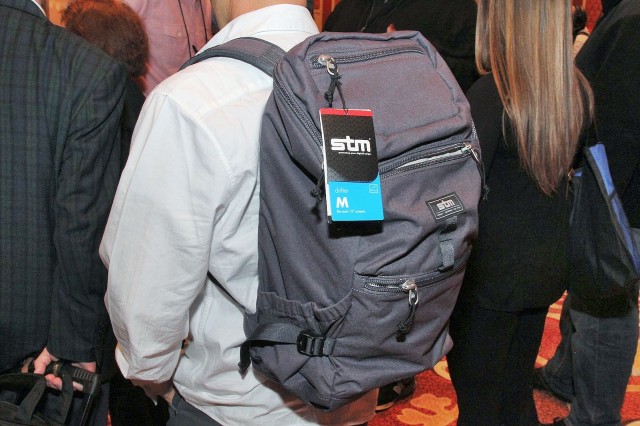
It’s a bit odd to be thanked for cussing; but that’s exactly what STM Bags owner Ethan Nyquist did when I walked over to the STM table during a press event at CES. Apparently he was considerably impressed with an enthusiastic exclamation I made about STM’s bags, in response to the announcement of one of their new backpacks*. Hey, what can I say — I’m a bag junkie, and I get passionate about stuff I like.
So here then, is a prediction: STM’s new Drifter will deepen the outfit’s rep as a maker of stellar bags.
 The Drifter is a departure for the Aussie outfit; it’s larger — the largest they’ve ever made — and seems more like a stuff-all pack for adventurous roaming than one of their business-like mobile offices. And it felt lighter than it looked.
The Drifter is a departure for the Aussie outfit; it’s larger — the largest they’ve ever made — and seems more like a stuff-all pack for adventurous roaming than one of their business-like mobile offices. And it felt lighter than it looked.
STM’s bags are generally constructed with markedly different fabrics than the majority of bags out there; the Drifter follows the pattern, with a soft-yet-tough-feeling texture to the fabric. Also cool: the female buckle on the sternum strap is metal.
Then there are the pockets — tons and tons of them. Three small zippered stashes on the outside, two for water bottles, a mesh pocket inside the lid, a document sleeve and of course, a laptop sleeve. Padding galore. A final surprise: there’s a waterproof raincover hidden in the bottom of the pack, where it doubles as bottom padding when not in use. Smart. No word on pricing or availability yet.
*clarification: While I think STM makes great bags in general, the bag that was announced at that time — the Velocity — has issues. Well, one big issue. Review forthcoming.
— Eli Milchman
Finally, A Bluetooth Speaker That Sits In Cupholders
If there’s one thing the fine citizens of the United States love in their cars it’s cup holders. God knows why a car needs like 20 places to stow a bucket of coffee or soda, but it does. Which means, ironically, that the average U.S. car has an average of 16[1] cup holders empty at any one time.
Thankfully, the SpeeCup is here to fill up at least one of them, although given the amount of free cup-holder space available, it seems almost silly to combine a speaker, a Siri-enabled mic and a cup-shaped vessel into just one single gadget.
 The SpeeCup, which sounds rather like something your doctor might ask you to take to the bathroom and fill up, is a Bluetooth speaker and Siri-compatible mic in a cup. The unit sits in any handily-available cup holder. It measure eight inches, and lasts for up to 20 hours on a charge (although you probably won’t have to worry about that as you have a car charger right there in your car).
The SpeeCup, which sounds rather like something your doctor might ask you to take to the bathroom and fill up, is a Bluetooth speaker and Siri-compatible mic in a cup. The unit sits in any handily-available cup holder. It measure eight inches, and lasts for up to 20 hours on a charge (although you probably won’t have to worry about that as you have a car charger right there in your car).
Prefer to use your actual car stereo to listen to music in your car? Of course you do, so you can hook the cup up via a line-out jack, and still beam music via Bluetooth from your iPhone, using the controls on the top of the SpeeCup to skip, play and pause your music. Don’t have a car? Good. You can also jam this into the bottle holder on your bike. Or just use it as a Bluetooth receiver for your home stereo.
The SpeeCup can be had right now, for “just” $130.
Source: SpeeCup
Made up statistic. ↩
— Charlie Sorrel
New 3D Printers Include Entry-Level Replicator Mini
We called it a “badass” product when MakerBot announced their Replicator 2X at last year’s CES, and now the company is back with three new 3D printers — including the Replicator Mini, which is being pitched as an affordable desktop unit for beginners.
“This is fifth-generation technology that’s setting the standard for reliability, quality, and connectivity,” MakerBot CEO Bre Pettis said of the new Replicator printer. “It’s our fastest and easiest 3D printer to use.”
In addition to the Replicator Mini — which has a build volume of 75 cubic inches — MakerBot’s new flagship Replicator desktop 3D printer has a build volume of 456 cubic inches, while its industrial-class additive manufacturing box the Replicator Z18, increases this to 2,592 cubic inches.
The Replicator Mini prints at a 200-micron resolution, while the larger units can print at 100-micron resolution. The printers can use biodegradable PLA filament, which serves as a greener, more sustainable alternative to ABS plastic.
The new printers come packed with 3D-printing software and firmware, alongside cloud-connecting capabilities, which mean that “you can connect to [them] however you want [using] a phone, a tablet, or your desktop computer.”
They additionally feature 3.5-inch color LCD screens to enable users to monitor the progress of their print jobs, and set up Wi-Fi and Ethernet connections with other systems and devices.
The MakerBot 3D Printing Platform also includes new applications for desktop and mobile — including MakerBot PrintShop, which is described as a “fun, easy, and free way to create and 3D print unique items,” and the MakerBot Digital Store in which users can “purchase, download, and print incredible MakerBot Verified 3D collections and models.” the company said in a news release.
The new Replicator 3D printer is currently available to purchase — while the Replicator Mini and Replicator Z18 are set to ship later this year.
MakerBot also announced that it is entering a “strategic alliance with innovative 3D vision company SoftKinetic” to make future 3D scanning products. — Luke Dormehl
